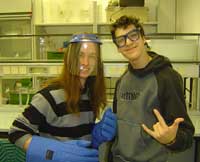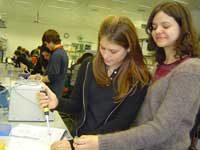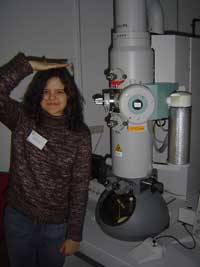The Bio Academy Teach article
French biology teacher Jean-Yves Guichot explains his project to link secondary-school students with molecular biology researchers.
The idea for this project came to me during a teacher training course organised by the European Learning Laboratory for the Life Sciences (ELLS) at the European Molecular Biology Laboratory (EMBL).
Several years ago, I had taken a break from teaching to spend a year at the University of Grenoble, France, doing research on plant gene expression. I had found the experience very rewarding and thought it would be great if I could find a way to expose my biology students to the work of researchers. I wanted to offer my students the chance to:
- Perform molecular biology experiments in a lab
- Follow the advancement of a scientific research project over a period of two years (the students would get regular input from the scientists by email and phone calls)
- Explain this research (and other topics of molecular biology) to other students via a website, which they should update regularly
- Learn about the reality of working as a scientific researcher, and realise that a scientific career lies within their reach.
How to set up such a collaboration
I feel that the experience was truly beneficial, and I loved getting back in touch with experimental research. If you would like to organise a similar event for your students, you might find the following hints and advice helpful:
- Find a research laboratory with young scientists who are willing to collaborate, and find a good contact there. In larger universities, school liaison officers are in charge of linking secondary schools with research departments at their university.
- Convince the head of your school that the project is important. Explain that it will give students the opportunity to meet researchers and work closely with them. It is also a challenge for the students – stretching their abilities and offering them the chance to learn new skills that cannot be gained in school laboratories. Students are more enthusiastic about learning advanced science when faced with a ‘high-tech’ environment and real scientists. It is also worth producing a detailed programme with the aims and procedures in order to ask the school for some funding to help cover accommodation and transport costs.
- Form several teams of 3-4 students and allocate these teams to one or two researchers. It is a good idea to have a few meetings with the researchers beforehand to consider possible topics and experiments. Then tell the students about these topics in class, and let them make their own choices. The students can keep in touch with the researchers by email to discuss their research.
- Take the students to a training course at the chosen research facility to practise and understand the work of their researcher partners, watching and performing experiments in the lab.
- Get the students to write about what they did and what they understood during their training course, and they can then send their work to be corrected by the researchers.
- Create and manage a website to collate the reports and other work (interviews with scientists, description of techniques, guided tour of the laboratory, etc.). Many secondary schools have their own website, so it should be possible to ask for a dedicated space on this site for use by your students. There is nothing more motivating for them than to see the almost instantaneous publication of their work on a website that is easily accessible to everyone.
- Every two years, repeat the experience with a new class, so that they can follow the research and keep the website going with new information. The researchers may have finished their PhDs and left the institute, but their projects may be continued by others.
Through contact with the ELLS team, my students and I were soon taking part in an exciting collaboration: the Bio Academy. In February 2006, 14 biology students aged 17 and 18 who were studying for the European Baccalaureate at the European School in Brussels, Belgium, visited EMBL for the first time to work alongside and talk to young French-speaking scientific researchers:
- Team 1: Cleo, Stella and Claude-Lee studied the dynamics of chromosomes during mitosis with Felipe Mora-Bermúdez
- Team 2: Lukas, Vincent, Georgios and Roxane researched the immune defence mechanisms of mosquitoes against malarial agents with Stéphanie Blandin
- Team 3: Simon, Karin and Charline looked at the role of kinesin in mitosis and the mitotic spindle with Julie Cahu and Aurélien Olichon
- Team 4: Zoé, William, Paul and Gery worked on the embryonic development of the fruit fly with Céline Pugieux and Jean-Baptiste Coutelis.

experiments
Image courtesy of Jean-Yves Guichot
During their second visit to EMBL, a year later, each team of 3-4 students presented the work they had produced with their mentor scientists to the entire Bio Academy. Then, each team met with their mentors to learn about recent developments in the research projects and to perform experiments related to the different scientific topics. The students also had the chance to talk to these young experts about issues related to their own future, such as the reality of work as a scientist, and university life.
To give the students a taste of a research facility in action, there were plenty of opportunities for all students to take part in hands-on activities using state-of-the-art techniques such as X-ray crystallographyw5, ELISA and electron microscopy. After their visit, the students put details of their work and described the techniques they had used on the project website.
At the end of this two-year project, three of the young scientists returned the visit, taking part in the La recherche en fête event at the school in Brussels, helped by the Bio Academy students. All school students who were interested in biology had the opportunity to meet the researchers and work with materials that they had brought along (fruit flies for genetic experiments, live cells to study mitosis).

Image courtesy of Jean-Yves Guichot
Early in their careers, scientists are really busy: collecting data, learning new techniques, writing up papers and dissertations. Why on Earth would they spend their valuable time running workshops and discussing their research projects with school students? “Because it’s fun to talk about science with young people,” says Felipe Mora Bermúdez, one of the scientists. “They are so imaginative and curious. We often tend to focus on our specific research, with little time to step back and see the bigger picture. Having a group of enthusiastic students asking intelligent questions helps us to look at our work from a different perspective.”
“It was an amazing experience to meet potential future scientists,” says Aurélien Olichon. “They were wonderfully well informed about the molecular level of life, which I didn’t have a clue about when I was their age. They even asked probing questions about modern biological research.” All scientists came to realise just how distant they are from current school science, and how challenging it is to explain complex molecular science in a simple way.
The students were grateful for the effort: “I really appreciated the opportunity to get to know some of the researchers who could answer my questions and share their thoughts with me,” said Zoé, aged 18. “They told me a lot about the challenging parts of their career: you have to cope with a lot of stress, and there isn’t any guarantee you will always have a job, so you really need to work hard. However, the diversity of the work, the possibility to create international connections with other researchers, the passion for science and the satisfaction of doing what you like makes it a very attractive career…and I think I might just have the courage to dive in.” Zoé is one of seven Bio Academy participants who went on to study medicine, while Stella is now studying cellular biology (see box below). Altogether, eight out of the 14 participants went on to biomedical studies – an indication of the project’s success.
There was plenty of fun too – good food, films and an experimental treasure hunt, for which the students performed three types of activities: DNA gel electrophoresis, protein separation in columns, and molecule model building. For each successful activity, the students obtained a number of pieces of a puzzle, corresponding to a treasure map. The group discovered the ‘treasure’ hidden on the EMBL campus, consisting of EMBL publicity materials (T-shirts, ties, key holders, mouse pads, notebooks, pencils and pens) and some sweets to supply them with energy for the train trip back to Brussels.
Felipe Mora Bermúdez summed up the whole experience perfectly: “All students enjoyed it, and these two visits showed them that science is a challenge…but an extremely fun challenge.”
Participants’ experiences

microscope
Image courtesy of Jean-Yves Guichot
Zoé Pletschette, aged 20, is now studying medicine at the Free University of Brussels, Belgium:
“The Bio Academy really reinforced my intention to be part of the scientific community. At school, science was all theory: we had to integrate all sorts of scientific facts and rarely gave a thought to how they were generated in the first place. Meeting such enthusiastic researchers allowed me to appreciate the practical aspects of the scientific world and how incredibly varied and exciting it is. Even if I stayed with my first career choice, medicine, I wouldn’t mind joining a lab in a few years, something I would have (wrongly) thought to be very boring before my visit to EMBL.”
Stella Diamant, aged 20, is now studying biology at the University of Warwick, UK:
“Although I had always been passionate about biology, I wanted to see what research was really like. Meeting friendly scientists and getting an insight into their current work was a revelation. Everything suddenly fell into place and made sense. The topics we learned at school turned into visible processes. What impressed me the most though was the working environment, how people joined forces for the sake of science and discovery. At school, ‘university’ always sounded like an unreachable new universe. However, having met the EMBL scientists, I didn’t hesitate to apply for a place at a UK university, and I am glad I chose a career which fulfils my curiosity every day.”
Acknowledgements
I would like to thank all the researchers who gave up their precious time for me and for my students. Without them, nothing would have been possible. Special thanks also to Alexandra Manaia who co-ordinated the training courses in Heidelberg.
Web References
- w1 – The European Learning Laboratory for the Life Sciences (ELLS) is an education facility to bring secondary-school teachers into a research laboratory. Based at EMBL Heidelberg, Germany, it welcomes European teachers to its free three-day practical workshops. Education materials designed together with teachers are available in the ELLS TeachingBASE. See: www.embl.org/ells
- w2 – For more information about EMBL, see: www.embl.org
- w3 – Further information about the Bio Academy visits to EMBL is available on the EMBL websitew2, and can be viewed directly here: http://tinyurl.com/l522ru and http://tinyurl.com/n4vyxs
- w4 – Find out more about the European School Bruxelles I here: www.eeb1.com
- w5 – To perform protein crystallography experiments with your own class, see:
- Blattmann B, Sticher P (2009) Growing crystals from protein. Science in School 11: 30-36.
- w6 – The Bio Academy website (in French) includes the students’ reports on their activities at EMBL, information they learned, pictures of the teams and much more. See: www.bioacademy.eeb1.com
Institutions
Review
In this article, Jean-Yves Guichot describes his science teaching project, in which a group of upper secondary-school students experienced molecular biology research at EMBL in Heidelberg, Germany. It was very successful, resulting in over half of the students enrolling in biomedical studies at university.
The author gives advice on how to set up similar school projects. The web references allow the reader to deepen their knowledge of the Bio Academy project through documents and materials created by the students.
I recommend this article to secondary-school teachers interested in filling the gap between science teaching at school and doing ‘the real thing’ in research labs. If they need encouragement to plan a joint project with a science faculty or research institution in their country, Guichot’s account is very helpful.
Giulia Realdon, Italy





